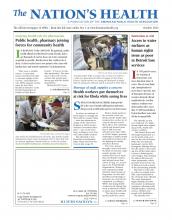When it comes to tobacco use, it isn’t uncommon to see plenty of warnings about the health risks of cigarette smoking. But another form of tobacco, smokeless tobacco, also carries risks, even without the spark of a lighter.
Smokeless tobacco is usually chewed, snorted or placed outside the gums, according to the Substance Abuse and Mental Health Services Administration. It has the same nicotine — a stimulant that could lead to addiction — found in cigarettes.

Photo by Natalie McGill
Smokeless tobacco, such as dip and pouches known as snus, may appeal to some people because they can be used in places where smoking is prohibited, says Brian King, PhD, a senior scientific advisor at the Centers for Disease Control and Prevention’s Office on Smoking and Health.
Smokeless tobacco is particularly popular among men and young adults. One in 10 male high school students in the United States uses smokeless tobacco — double the rate of adult males, King says.
“That’s very concerning to us, because we know if you start at this young age, that could potentially lead to a lifetime of nicotine addiction and the adverse health effects associated with smokeless tobacco use,” King says.
The risk for addiction is real. The amount of nicotine users get from smokeless tobacco could be three to four times higher than the nicotine they get from smoking cigarettes, according to SAMHSA.
Someone who uses two cans of snuff — ground tobacco that is snorted through the nose — per week can get as much nicotine as someone who smokes a pack and a half of cigarettes a day, according to the National Institute of Dental and Craniofacial Research.
And the adverse health effects are no less serious than the risks to a cigarette smoker. Smokeless tobacco users are at a higher risk for oral cancer, as well as cancers of the lip, throat and the lining of the cheek and the pancreas. Aside from cancer, smokeless users are also at risk of tooth decay, cavities, gingivitis and gum disease, King says.
Snuffing out tobacco use
If you use smokeless tobacco and are looking for ways to quit, there are options for you, many of which are proven methods to help people quit smoking. King says the most important first step you can take is to talk with a doctor about your desire to quit. A doctor can help suggest tips to stop your habit, which may include nicotine replacement therapy.
“There’s extensive evidence showing that the use of these types of products, like the nicotine patch and the nicotine gum, considerably increase the likelihood that people can successfully quit,” King says. “So it’s very important that people utilize their health care professionals and also these proven, (Food and Drug Administration-) approved medications.”
Setting a date for when you’ll quit can be a motivator, the institute says. You’ll want to let friends and family members know you’re trying to quit and that you’ll need their support through any triumph or setback. You may also want to set up an appointment with a dentist to examine your mouth before you begin.
Start to wean yourself off by starting to use fewer and fewer smokeless products. Use half as much as you normally would and consider chewing alternatives such as hard candy or gum, the institute says. Avoid carrying smokeless tobacco containers with you and nail down what times during the day you get the strongest urge to use smokeless tobacco. Those are the times when you’ll want to have a substitute ready to combat your cravings.
King also warns that people who are trying to quit cigarettes shouldn’t look to smokeless tobacco as a safer alternative. He says using smokeless tobacco that way can undermine your quit attempt, lead to higher smoking rates and encourage a use of both products at the same time.
“The ultimate goal of quitting is to quit all forms of tobacco use altogether and not to shift from a combustible product to a smokeless tobacco product because we know that smokeless tobacco is not a safe substitute for smoking cigarettes,” he says. “Smokeless tobacco use still represents health risks for people.”
Kicking the habit: Free quitlines can help
If you’re ready to quit, free resources are available to help — and many are just a phone call away.
Tobacco quitlines are available in every U.S. state, and they aren’t just for smokers. People who want to kick their smokeless tobacco habit can call and talk with a counselor about the best way to go about it. Smokeless tobacco users can get advice on ways to cope with cravings or how to create a quit plan.
If you’re mulling quitting, 1-800-QUIT-NOW is a good place to start.
For more information on tobacco risks, visit www.cdc.gov/tobacco/osh
- Copyright The Nation’s Health, American Public Health Association









